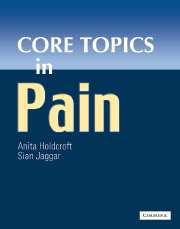Book contents
- Frontmatter
- Contents
- Contributors
- Preface
- Acknowledgements
- Foreword
- General abbreviations
- Basic science abbreviations
- PART 1 BASIC SCIENCE
- 1 Overview of pain pathways
- 2 Peripheral mechanisms
- 3 Central mechanisms
- 4 Pharmacogenomics and pain
- 5 Peripheral and central sensitization
- 6 Inflammation and pain
- 7 Nerve damage and its relationship to neuropathic pain
- 8 Receptor mechanisms
- PART 2 PAIN ASSESSMENT
- Section 2a Pain measurement
- Section 2b Diagnostic strategies
- PART 3 PAIN IN THE CLINICAL SETTING
- Section 3a Clinical presentations
- Section 3b Pain syndromes
- PART 4 THE ROLE OF EVIDENCE IN PAIN MANAGEMENT
- PART 5 TREATMENT OF PAIN
- Section 5a General Principles
- Section 5b Physical treatments
- Section 5c Pharmacology
- Section 5d Psychosocial
- PART 6 SUMMARIES
- Glossary
- Index
8 - Receptor mechanisms
from PART 1 - BASIC SCIENCE
Published online by Cambridge University Press: 10 December 2009
- Frontmatter
- Contents
- Contributors
- Preface
- Acknowledgements
- Foreword
- General abbreviations
- Basic science abbreviations
- PART 1 BASIC SCIENCE
- 1 Overview of pain pathways
- 2 Peripheral mechanisms
- 3 Central mechanisms
- 4 Pharmacogenomics and pain
- 5 Peripheral and central sensitization
- 6 Inflammation and pain
- 7 Nerve damage and its relationship to neuropathic pain
- 8 Receptor mechanisms
- PART 2 PAIN ASSESSMENT
- Section 2a Pain measurement
- Section 2b Diagnostic strategies
- PART 3 PAIN IN THE CLINICAL SETTING
- Section 3a Clinical presentations
- Section 3b Pain syndromes
- PART 4 THE ROLE OF EVIDENCE IN PAIN MANAGEMENT
- PART 5 TREATMENT OF PAIN
- Section 5a General Principles
- Section 5b Physical treatments
- Section 5c Pharmacology
- Section 5d Psychosocial
- PART 6 SUMMARIES
- Glossary
- Index
Summary
Pain serves a vital biological defensive function, often associated with other psychological and central disturbances. It is a physiological condition, which is detected by refined receptors within the damaged body tissues. It has two components: the motivational-affective (emotional) component and the sensory-discriminative component. Nociception and pain are not necessarily analogous. Nociception is the term applied to perception of nociceptor activation by noxious stimuli, whereas pain refers to a subjective response. One pain classification describes: physiological, inflammatory (from tissue damage) and neuropathic pain (from changes in nerves) with peripheral and central nervous system (PNS and CNS, respectively) changes some of which may be permanent, altering the brain's future perspective of pain. We describe basic receptor pharma cology and then some of the more important and unusual receptors in the ‘pain pathway’.
General terminology
Some of the terms used in receptor pharmacology are described below:
Ligand: General term for a molecule (peptidic, chemical, ionic or synthetic), which binds at a receptor site.
Agonist: Ligand that binds at, and activates, a regulatory receptor to produce a pharmacological response (can be a full or partial response).
Antagonist: Ligand that binds at a receptor site but does not produce a response. Binding is generally, but not exclusively, reversible (competitive) and attenuates the effect of an agonist.
[…]
- Type
- Chapter
- Information
- Core Topics in Pain , pp. 49 - 62Publisher: Cambridge University PressPrint publication year: 2005

